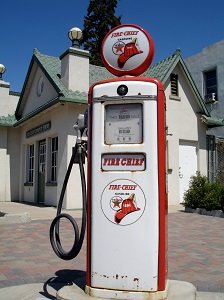If you’re past “a certain age,” you might remember when gas was $1.50 per gallon, or $1.00 per gallon, or 59 cents, or what-have-you…but the truth is that everything has gotten more expensive. After all, when gas was $1.00 per gallon, a nicely tricked-out Chevrolet Caprice Classic was selling for about $6,000 brand new.
Thank you for reading this post, don't forget to subscribe!Now that we’re well into the 21st century, gas prices are likely to fluctuate, but one thing’s for sure: gas is likely to never be “cheap” again. We know that everyone’s trying to get a little more out of every dollar, and whether you’re driving a big SUV or a subcompact, there are things you can do to help your vehicle’s fuel economy:
• Watch your right foot. This is probably the most important thing on the list. It takes a lot of energy and fuel to get your car moving, whether it’s a 5500-pound Chevy Yukon or a 2700-pound Mini. Every time you accelerate hard, you’re unnecessarily dumping more fuel into the engine, which can cost you as much as 1 to 3 mpg around town. Remember that you’re not in a race and you don’t have anything to prove. Consider leaving a little early to get to your destination so that you don’t feel like you have to stomp the gas pedal and drive hard to get there.
• Think ahead. In many cities, stoplights are synchronized so that driving at a certain speed will get you nothing but green lights. If they aren’t, though, or if you see a single red light a few blocks ahead, try to coast and slow down so that the light will be green by the time you roll through it. You can also keep your distance from other drivers and (hopefully) anticipate their next move so that you can avoid braking.
• Use your cruise control. Regardless of how steady your right foot might be, it can’t keep your car at the same exact, consistent speed nearly as well as cruise control can. Cruise control can also help reduce driver fatigue on long trips. It’s not advisable for heavy traffic, wet-weather or mountainous driving, but if you’ve got a long, open expanse of interstate ahead of you, set that cruise control for a reasonable speed and let it save you money.
• Slow down. It might be frustrating for some to drive slower, but it makes a big, big difference in fuel economy. Every 5 mph you are driving over the speed limit is costing you more money in fuel. For some vehicles, every 10 mph represents a 15 percent hit on your gas mileage. We know that on many stretches of highway, a driver keeping it at 70 is a rolling roadblock for other drivers, but keep your speed down, hang out in the right lane and let them blow past you. You might get there a few minutes later, but like we said before…just leave the house a little earlier. Besides, once you get more than 5 mph over the speed limit, you risk attracting the attention of state troopers.
• Unload your trunk. Especially in a minivan or SUV, it’s easy to accumulate extraneous junk and forget about it, but every 100 lbs of unneeded weight can cost you one to two percent of your fuel economy. On a long trip, you might be hauling people and luggage, which is understandable…but around town, get a look in your trunk and chunk any concrete blocks, sandbags, lead ingots or bowling balls you might have forgotten back there.
• Streamline your vehicle. Aerodynamic efficiency is a huge part of fuel economy…that’s why our cars now look more like jellybeans than bars of soap. If your vehicle has a ski rack, bike rack, top-mounted cargo carrier or other accessories, take them off unless you really need them.
• Cut your idling time. A car that’s idling gets zero mpg, and does nothing but sit there and burn fuel. If you’re going to be sitting for more than about a minute, just shut the engine off and start it again when it’s time to move out. It may be uncomfortable in hot or cold weather, but it makes as much sense as shutting off the lights when you leave a room.
• Use your car’s travel computer. If your car’s equipped with a computer that indicates real-time fuel economy, average fuel economy and Distance to Empty, pay attention to it, especially when your real-time mileage is dropping to single digits when you accelerate. The math on those devices is pretty accurate!
• Check your tires. You’ve undoubtedly heard this one before. Underinflated tires mean more friction and rolling resistance, and that hurts your fuel economy. Tires lose a pound or so of air pressure every month, so regularly check your inflation levels and add air if needed. You can find proper inflation levels on your car’s driver’s door frame, under the hood, inside the fuel filler door or in the owner’s manual. If it’s almost time for new tires, consider going to low-rolling-resistance tires.
• Keep your car well maintained. If your Check Engine light is on, have it diagnosed and fixed. If you can’t remember the last time your air filter was changed…change it. Newer cars are designed for light grades of motor oil, and heavier grades can actually cut the engine’s efficiency.
• Use your A/C sparingly. At one time, the rule was to avoid A/C altogether on the highway. That’s changed somewhat, as newer A/C systems don’t put as much parasitic drag on the engine and vehicle aerodynamics have improved to a point where running with the windows down at highway speed actually creates more drag. Still, if it’s a nice day, roll those windows down and enjoy the breeze while you’re tooling around town.
• Don’t drive. If you need a couple of things from the convenience store and it’s only three blocks away, just walk down there and back. You can also take the bus, carpool to work, ride a bike and come up with all kinds of other options that don’t involve a single person driving a 4000-pound vehicle for a mile or two.


